
Sapphire X800 XL
Written by John Yan on 2/14/2005 for
PC
More On:
Sapphire X800 XL

We’re starting to see a lot of PCI-E cards hitting the market as we’re in this transition period between new technologies. There’s a nice range of choices and today we have a card that’s not on the high end of the spectrum but it’s up there and should provide some fast gaming. Sapphire was kind enough to send us the ATI Radeon X800 XL to test out.

Announced a few months ago, the Radeon X800 XL is a PCI-Express native card built on the .110nm manufacturing process with 16 pipelines and 256MB of memory with a 256-bit memory interface. The clock speed of the card sits at 400MHz engine clock speed and 490MHz (980MHz DDR) fir the memory clock speed. With the specs, the card has potential pixel fillrate of 6.4 Gpixels/sec.
As far as features go, there’s nothing new in terms of support for technology. It might be a few more months before we see something new to the Radeon line but the features in the X800 XL contains the same feature support as the previous cards. Here’s a comparison of a few of ATI’s cards:

The Radeon X800 XL fills in the $300 price range for a PCI-E video card but can you get it for that much? A current scan of pricwatch and pricegrabber shows prices of $370 and up; certainly making this card’s price to performance ratio invalid with what the card should be selling for. Until we see these cards in higher circulation, the price will stay high. That’s too bad as I think this card would be a great seller at its MSRP once you see the benches this card puts up.
The Sapphire branded card is pretty vanilla with nothing out of the ordinary. With the only real change from the reference board being the branding on the heatsink fan unit, the Sapphire card lacks any innovation. I’m guessing they will try their hand at a Toxic version of this card down the road like they did with the X800 Pro and the X700 recently. Otherwise, this is the same card you would get if you ordered an ATI one.
Because of the PCI-Express interface, the card doesn’t need an external power supply like the recent AGP high end cards. PCI-Express allows for more power to be supplied to the card so the exclusion of a molex connector is most welcomed. Also, the card’s design makes it a single slot solution and should make SFF owners and those wanting a single slot card very happy.
One of the nice things about Sapphire’s offerings are the bundles and the X800 XL card I received features two great games. Splinter Cell: Pandora Tomorrow and Prince of Persia: Sands of Time are included along with a good software suite. That’s two well received game that’s a great addition to anyone’s library.
We’re going to be comparing this card to the ATI Radeon X700 Pro and the WinFast GF6600 GT TDH. The 6600GT comes in at about $100 less than the MSRP of the Radeon X800 XL. While not really a direct competitor, the card is one of the few PCI-E cards in our office that was closest to the X800 XL. Our test system includes:
AMD64 3800+
2 OCZ PC3200 256MB of ram
ATI Radeon 200P microATX motherboard
120 GIG Maxtor 7200RPM HD
Windows XP w/ Service Pack 2

3DMark05 is the only synthetic benchmark we are using today. From their website: It is the first benchmark to require a DirectX9.0 compliant hardware with support for Pixel Shaders 2.0 or higher! By combining high quality 3D tests, CPU tests, feature tests, image quality tools, and much more, 3DMark05 is a premium benchmark for evaluating the latest generation of gaming hardware.
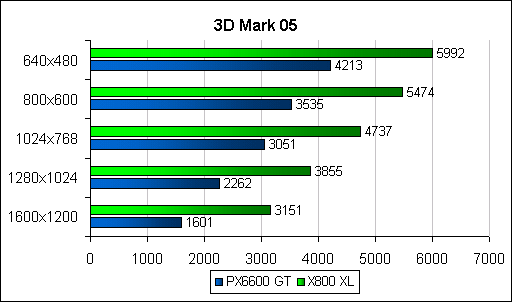
Not surprisingly, the X800 XL wins handily over the NVIDIA card.

An instant classic, Half-Life 2 is one of the best games I’ve played and features some great visuals. The Source engine was engineered with ATI in mind and the game runs very well on ATI hardware.
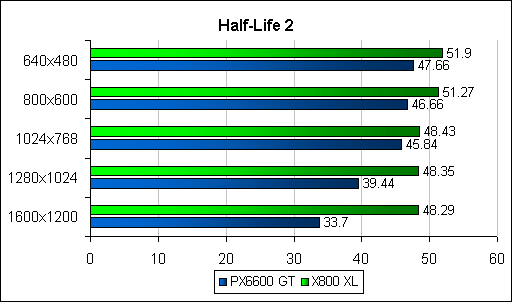
The more powerful card really pulls away at the higher resolutions.

iD’s latest, Doom 3, pushes graphics cards to the limit. The game will even support cards with 512MB of ram when they are released. The dark atmosphere and smooth characters generate an incredible visual atmosphere that remind me of many horror movies.
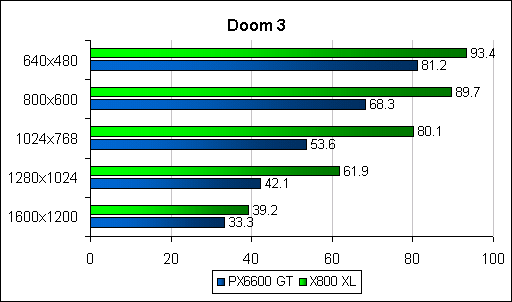
The Sapphire card runs the game really well up to 1280x1024. For Doom 3 performance, the card does a nice job churning out those demonic polygons.

Halo is the Microsoft/Bungie/Gearbox first person shooter originally appearing on the Xbox. Featuring great graphics, vehicles, and good gameplay Halo is ran with max settings as well with Pixel Shader 2.0.
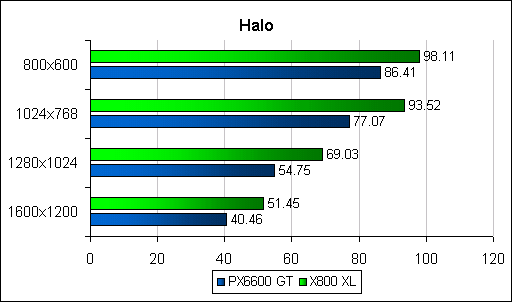
As with the previous tests, the Sapphire card gives a great all around performance on each resolution up to 1600x1200.

Far Cry is a first person shooter that delivers lush outdoor settings, fast action, and many vehicles for you to use. Discover a whole island and see out far into the distance as you encounter mercenaries and monsters.
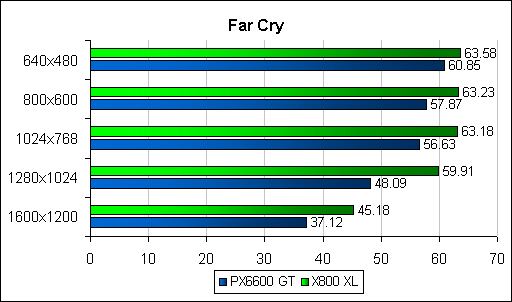
The X800 XL runs Far Cry at or more than 60 frames per second from 1280x1024 and down. That’s pretty damn fast and gives great playable performance at varying resolutions.

Unreal Tournament 2004 is still fun to play and I have a blast with it at LAN parties. While it’s starting to get a little old, it still looks gorgeous and features great gameplay. This is what 2003 should’ve been and with the added Onslaught mode, the game’s one of the best LAN games out there right now.
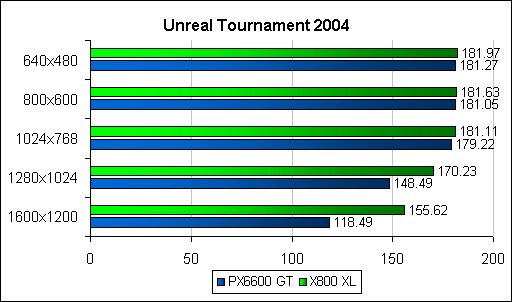
If you play this game, you can crank the resolution way up as it will probably never dip to stuttering levels with the speeds this card exhibits.

Call of Duty is a Quake 3 engine powered WWII shooter that’s one of my favorites. The single player experience is great fun and one of the few games I replayed over and over again after finishing.
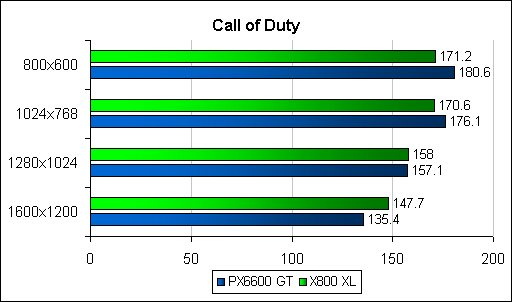
Like UT2K4, Call of Duty runs blazingly fast in all resolutions with max details on.
Now let’s take a look at how the card scales when you start turning on anisotropic filtering and anti-aliasing. We’ll test Half-Life 2, Doom 3, Far Cry, and Unreal Tournametn 2004.


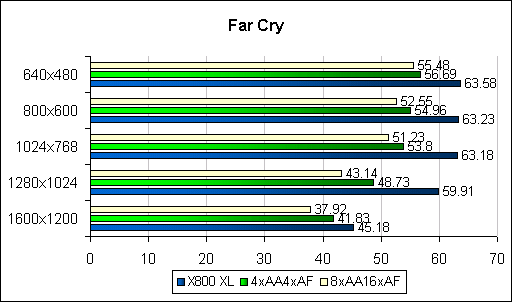
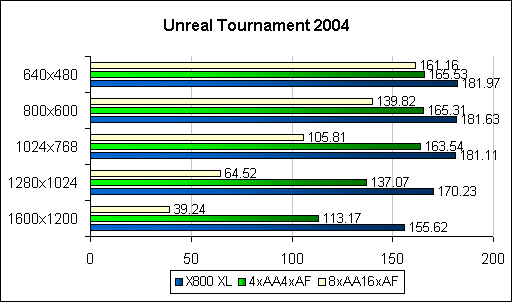
Turning 4xAA and 4xAF will generate a higher quality picture and won’t tax your card too much. I definitely keep those options on when I am playing games at a mid-range resolution. Once you max out both, you see some big drops so only turn it on max at low resolutions and that’s only with certain games. Doom 3 absolutely crawls as you can see from the graph at high AA and AF settings.
It’s really sad to see this card not coming in at the MSRP as for that price, it’s a great buy. Sapphire’s card is pretty vanilla but the bundle is pretty good and they always have solid cards. All the Sapphire cards that I’ve tested have worked like a champ and this one is no exception. I ran the card through long loops of 3D Mark 05 and played many hours of FPS games with it. All through it all I had a great experience and I was very happy at how it performed. The X800 XL, once it becomes readily available, should be heavily considered if you have $300 to spend on a video card.
Sapphire has a very nice card here that offers a lot of performance for the price. The only problem is that the card is, as of this writing, way over priced because of supply and demand issues. Let's hope it gets to the MSRP or a little below soon.
Rating: 9.1 Class Leading
* The product in this article was sent to us by the developer/company.

About Author
I've been reviewing products since 1997 and started out at Gaming Nexus. As one of the original writers, I was tapped to do action games and hardware. Nowadays, I work with a great group of folks on here to bring to you news and reviews on all things PC and consoles.
As for what I enjoy, I love action and survival games. I'm more of a PC gamer now than I used to be, but still enjoy the occasional console fair. Lately, I've been really playing a ton of retro games after building an arcade cabinet for myself and the kids. There's some old games I love to revisit and the cabinet really does a great job at bringing back that nostalgic feeling of going to the arcade.
View Profile